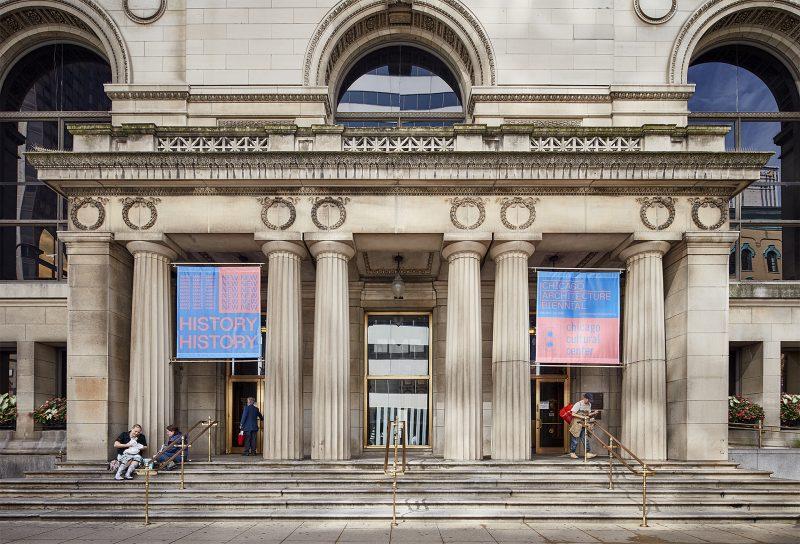Imagine the historic, decaying St. Stephen’s Church in Hyde Park re-imagined, restored and repurposed. Instead of the space being used as a traditional religious sanctuary, what if the church was transformed and featured a community swimming pool?
This was the idea behind the winning entry for the Chicago Architecture Club’s 2017 Burnham Prize, “New Waters” by Sonja Cheng, Jennifer Ly and Max Obata.

The competition encouraged creative minds to propose a plan to restore the space under St. Stephen’s Church dome in Chicago’s Hyde Park neighborhood. The challenge incorporated the theme of the 2017 Chicago Architecture Biennial (CAB), “Make New History,” and is showcased at the exhibition.
“Young architects were really thinking a lot about the relevance of history to contemporary questions,” executive director of the CAB, Todd Palmer said.
The winning design took the historical typography from the church’s dome, and redesigned a new interpretation of a public space.
The 2017 CAB is a design exhibition that showcases the collaborations between architects and artist’s innovative projects that are reshaping what will influence the future. It is the largest exhibition in North America. The Chicago Cultural Center is the host of the main exhibition that is running through Jan. 7, 2018.
Over 141 participants from 20 countries offer the public the opportunity to look at how the design and world of architecture is constantly changing. What is being produced from these participants is being committed to history. This sense of “making new history” comes from the idea of how new architecture references trends from the past to create a new vision for the future.
The Chicago Cultural Center at Randolph and Michigan, the original home of the Chicago Public Library, has three floors of curated designs that truly make the viewer wonder what our world will look like in the future. There are designs that are completely new construction projects of skyscrapers, but there are also a lot of plans that have created architectural projects from decrepit, old buildings that have been abandoned in cities across the world. Palmer says the theme was determined by the artistic curators Sharon Johnston and Mark Lee, who were tasked with the job of creating the 2017 theme.
“They took the temperature of the field and the observations of the tendencies and interests that were emerging, and those trends led them to the theme of history,” Palmer said.
The title of the biennial itself, “Make New History,” was borrowed from the title of artist Ed Ruscha’s book.

“What is interesting about the book is that the title “Make New History” is printed on the sides of each of the pages, and the pages are blank. It is a conceptual art piece that resonates with this year’s Biennial History. It is something we receive, like this book, but it is ultimately something that we are crafting, creating and engaging with,” Palmer said.
While the main exhibition is at the Chicago Cultural Center, there is a list of anchor hosts around the city of Chicago that are offering Biennial programming — including the DePaul Art Museum.
The DePaul Art Museum became an anchor host this year because the biennial wanted to grow its success by expanding its footprint into the different communities in Chicago.
“The different organizations that were contacted represented an interesting cross section of the city and are geographically diverse,” said associate curator at the DePaul Art Museum, Mia Lopez.
“The Biennial reached out to our Chief Curator Julia Rodrigues Widholm, and Widholm immediately thought of the artist Ângela Ferreira,” Lopez said.
Ferreira is an artist who is based out of Portugal, and she is showing her first U.S. solo-exhibition on the entire second floor of the art museum until Dec. 10. Lopez says Her work looks at the intersections of modernist architecture with post-colonial Africa.
“Modernism is synonymous with Chicago architecture,” Widholm said. “Ferreira’s work offers a unique post-colonial perspective on this familiar subject, while connecting Chicago to a global conversation around the history and politics of architectural forms and materials.”
Ferreira’s exhibit is an architectural structure entitled “Zip Zap, Circus School.” The exhibit was modeled after a circus in Cape Town, Africa that promoted youth empowerment and social transformation through the circus. The plans by Portugese architect Pancho Guedes were never developed. Ferreirs combined the architecture plans of Guedes with Mies van der Rohe’s modernist plans to create her own exhibit that allows the educational ideas of the past to come to fruition.
“Zip Zap, Circus School” is seeking students and youth empowerment groups to sign up for a time slot to interact with the exhibition. The interaction will bring life to the historical ideas, and they will combine with the cultural tendencies of today’s generations to ultimately create something entirely new.
The 2017 CAB is a culmination of artists and architects innovative, global ideas that are crafting the spaces in the world we live in. The ingenious theme is woven into every aspect of the experience. From the conception of the theme, to the title chosen from a book, to the history of the Chicago Cultural Center’s previous use as a public library— there is a consistency that is ultimately entirely satisfying.

